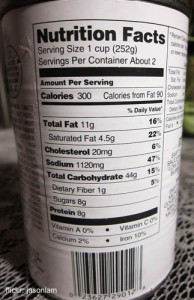The last few weeks I’ve been talking about getting clued in to the calories in some beers and smoothies so you can avoid unknowingly eating something with the same amount of calories as an ice cream sundae (because if you’re going to eat that many calories you may as well eat that sundae!).
Today I’m telling you the #1 thing you can do to avoid foods that secretly have tons of calories in them: read the nutrition label on the package. I mean it. It seems silly but only takes a second and can make a big difference. Here’s an example with the greek yogurt that I buy. I don’t prefer the “plain” kind so I was buying the “honey” flavor. One day I decided to put my money where my mouth is and double check the nutrition label on the different flavors. Low and behold, the (individual carton) “honey” flavor carries 240 calories while it’s neighbor, the “vanilla” flavor, has only 160. That is a HUGE difference for the same amount of yogurt and the two taste virtually the same. Needless to say I am buying the vanilla flavor now.
So if you were buying, say, a thin crust pepperoni pizza, you might be surprised to see that you can reduce your calorie intake simply by choosing Newman’s own (320 calories and 16 grams of fat per 1/2 pie) rather than Red Baron (400 calories and 19 grams of fat). And for desert, you’ll make a better choice if you compare Haagen Dazs chocolate sorbet (130 calories/serving) with Ben and Jerry’s Peanut Butter cup (360 calories/serving). By checking food labels you can literally make better choices even if you’re eating pizza and ice cream!
There are millions more examples but you will not know unless you take a second to flip the box around (or look at the menu- all restaurants in the US are required by federal law to provide calorie information). Think of it this way, If you are unknowingly eating an extra 80 calories, as I did in my example above, it’s a lot easier to look at a nutrition label and choose something else than it is to burn off an extra 80 calories via exercise.
Note: be sure to look at the serving size at the top of the nutrition label when comparing the calories between two foods.
Now I want to hear from you. Have you ever discovered that something was a real calorie trap? Share it with us so we can all benefit!
If you’re not on my list to get more health tips like these, enter your name and email below.





